|
Washington, DC-June 1 – The National Space Society (NSS) congratulates Elon Musk and the entire SpaceX team on the Dragon spacecraft’s historic mission to the International Space Station (ISS) and its safe return to Earth yesterday. “The mission was truly spectacular and marks a watershed moment in space history – proving that the commercial sector can successfully service the ISS,” said NSS Executive Director Paul E. Damphousse. “We were especially fortunate to celebrate the Dragon’s grappling at ISS on Friday morning with NASA Administrator Charles F. Bolden, Jr., who was at that very moment addressing an audience of nearly one thousand at NSS’s recent International Space Development Conference (ISDC).” ISDC, the National Space Society’s annual conference, wrapped up in Washington, DC earlier this week. Administrator Bolden was delivering the opening keynote speech just as Dragon approached and then berthed at the ISS. The safe return of Dragon and the advancement of commercial cargo and crew programs mark true milestones on the path to enabling a space-faring civilization. NASA’s efforts to advance space technology will also have a significant impact: technologies such as cryogenic propellant storage and transfer (CPST), solar electric propulsion (SEP), and advanced robotics are “mission-multipliers,” and are but a few examples being advanced by NASA’s Office of the Chief Technologist. These efforts will help to enable robust space operations while providing dramatic reductions in overall costs. The National Space Society recognizes that there is still much to be done, and maintains that strong leadership in government will be critical going forward. In this context, NSS calls on the Senate to fully fund the commercial crew development program and space technology lines of the NASA budget as proposed in the President’s budget request earlier this year, removing the proposed cuts made by the House in May. While NSS acknowledges the difficult budgetary parameters under which Congress must work, we strongly encourage both the Senate and the House to accede to the President’s FY2013 budget request for both commercial crew and space technology during conference later this year. “The successful conclusion of SpaceX’s COTS-2/3 missions has demonstrated that the commercial sector is now ready to move forward with increased responsibility for servicing ISS, including the development of crew transport capability,” Damphousse said. “If funded and executed correctly, the commercial crew program will end our sole reliance on foreign providers and bring that capability – and the jobs associated with it – back home. We should be preserving funding for these commercial and space technology programs – which are producing tangible successes today, and will continue to do so in the near-term and beyond – rather than shifting it to already well-funded programs that may be years away from providing results.” About the National Space Society: NSS is an independent, educational, grassroots, non-profit organization dedicated to the creation of a spacefaring civilization. Founded when the National Space Institute and the L5 Society merged in 1987, NSS is widely acknowledged as the preeminent citizen’s voice on space. NSS has over 10,000 members and supporters, and over 50 chapters in the United States and around the world. The society publishes Ad Astra magazine, an award-winning periodical chronicling the most important developments in space. To learn more, visit www.nss.org. |
Human Exploration
Dragon Completes Successful COTS 2,3 Mission
|
The Dragon spacecraft successfully completed all mission objectives and floats quietly in the Pacific Ocean off the coast of Mexico following reentry and splashdown.
|
Dragon – Reentry and Recovery
|
Reentry and Splashdown Timetable (Phoenix Time)
The Guidance, Navigation and Control (GNC) panel on Dragon has closed. At 6:41 Phoenix time (1341 UTC), Dragon is one hour and ten minutes from its deorbit burn. Reentry has been completed. Drogue chutes have been deployed. Main chutes have been deployed. All three chutes are open and in good shape. Splashdown is still on track for 8:44 AM Phoenix time (1544 UTC). Splashdown occurred at 8:42 AM (1542 UTC). Congratulations SpaceX. The images below show the parachute descent. Splashdown was pretty much on target. The recovery vessel saw the chutes. The NASA P3 plane has observed the chutes in the water. SpaceX reports that Dragon landed at 27° latitude and 120° longitude. The recovery vessel has the chutes in sight in the water. The main chutes have been released by Dragon. Certain systems aboard Dragon are being powered down prior to recovery. Dragon is floating in the Pacific Ocean in the “stable one” configuration. NASA TV will carry the Status Briefing at 11:00 AM Phoenix time (1800 UTC).
|
Dragon Comes Home
|
Unberthing is currently schedule for 1:05 AM Phoenix time (0805 UTC).
Dragon is currently equilibrating the pressure prior to departure. Image below shows the location of Dragon attached to the ISS. The location is the Pressurized Mating Adapter (PMA) attached to the Harmony node.
Dragon is attached to Canadarm and is slowly releasing the bolts and latches.
The Canadarm (Space Station Remote Manipulator System – SSRMS) is waiting for all the latches to be released prior to moving the Dragon to its release point. The breaks are on the SSRMS, preventing the arm from moving and damaging the docking and latching mechanisms. At 0755 UTC, work on the third set of bolts on the Common Berthing Mechanism (CBM) is in progress. We are about 10 minutes from release. At 0802 UTC, the fourth and final set of bolts is being released. And Dragon is released (demated) from the ISS at 0807 UTC.
Time on Station: 5 days, 16 hours, 5 minutes. Re-entry coverage begins on NASA TV at 7:15 Am Phoenix time (1415 UTC). Key events: 1451 UTC Deorbit burn |
Dagon Undocking and Re-Entry
|
Schedule for the morning (as of the MSB yesterday): 0630 UTC Unberthing coverage begins 1300 UTC ISS Update 1415 UTC Reentry coverage begins 1800 UTC Mission Status Briefing Events kickoff at 11:30 PM Phoenix time (0630 UTC).
|
ISDC 2012 – Jeff Greason and the Implications for Space Policy Advocacy
|
Last year at ISDC in Huntsville, Jeff Greason gave a rabble-rousing address wherein he maintained that the obvious, but unspoken word in current space policy was “settlement”. Not any specific program, but settlement. This year in Washington D. C., Jeff made a much more important statement; this time concerning commercial space and how to create a viable settlement. Thinking about his observations of the scary paradigm shift down which NASA has begun to be dragged kicking and screaming, I am reminded of the politics in Colorado in the 2004 -2006 congressional campaign. There were six or so special interest groups working to select a candidate. But the environmentalists would not support the labor union candidate because his constituents favored mining and harvesting forests. The women’s rights group would not support the environmental candidate because he was anti-abortion. And so it went. A politically astute gentleman, with considerable means, arrived to discuss the issue with the groups. He pointed out that if any one group withdrew from the coalition, they would lose the election, and the opposing party would elect a representative who was going to vote against each and every program that the respective groups wanted. He also pointed out that if this program oriented withdrawal of support were repeated state by state, then congress would be controlled by people who would roll back gains that each group had achieved over the years. On the other hand, if the groups agreed to compromise, to be willing to accept that in Colorado their candidate had to stand for mining and foresting in order to be elected, and they could show other coalitions in other states the same need to compromise and support an underlying need to elect people who supported most of their positions most of the time, then they would control congress and each of their issues stood a good chance of advancing. Although any individual congress critter might vote against an issue to satisfy their local situation, the majority would vote in favor. And finally, if a compromise candidate were truly supported by all, he would contribute a million dollars to the campaign. Now, in space policy, we have the Moon Society advocating for a Moon program. And we have the Mars Society advocating for a Mars program. We have the Planetary Society. We have the National Space Society. We have the Commercial Spaceflight Federation. We have many groups advocating for their program. And it is easy for the congress critters to ignore us. No one has a very big voice. What is needed is for all to advocate for the paradigm shift that Jeff discussed. Settlement, no matter where it will be or when it will be, will only be successful if we can migrate each step along the way (to wherever we go) off of the NASA budget and into the commercial sector. And we can only do that if we create the conditions that allow individuals, free people, to own the assets (labor and capital) that not only allow for subsistence, but for excess capacity, for success and failure. It is the excess capacity that will eventually result in wealth and trade. It is past time for the central planning of all space exploration efforts. We must all be advocating for the chaotic market within which commercial space can succeed. The combined voice will be strong enough to make a difference in the space policy debate. Dr. C. David Fischer, Jr [Ed. Note: The thoughts expressed here are the author’s, and do not reflect the thoughts or policy of the Phoenix Chapter of the National Space Society nor the National Space Society.] |
Dragon Cargo Transfer to the ISS
|
At 1200 UTC on Monday, 28 May, the crew of the International Space Station is busy unloading the 1,014 pounds of cargo brought up by the Dragon spacecraft. You can watch the process live at UStream. Activity will continue today and tomorrow. After that, the Dragon will be loaded with 1,367 pounds of science experiment results and other gear from ISS. On Thursday, Dragon is scheduled to depart from the ISS and return to Earth. Splashdown will be several hundred miles off the coast of Southern California.
|
NASA Administrator Calls Station Following SpaceX Historic Feat
|
25 May 2012 WASHINGTON — NASA Administrator Charles Bolden offered his congratulations to the International Space Station Expedition 31 crew and mission flight control teams at NASA’s Johnson Space Center in Houston and SpaceX’s headquarters in Hawthorne, Calif., following Friday’s successful first-time berthing of a commercial company spacecraft, SpaceX’s Dragon, to the space station. Bolden talked with NASA astronauts Don Pettit and Joe Acaba, and European Space Agency astronaut Andre Kuipers during a call to the space station Friday afternoon live on NASA Television. Bolden told the crew, “You made history today and have firmly locked into place the future direction of America’s space program.” |
“And it smells like a new car”
|
At 0953 UTC on Saturday morning, 26 May 2012, the hatch on Dragon was opened by Don Petitt aboard the International Space Station. The ISS was 253 miles above the Earth, near Auckland New Zealand. The crew installed the air ducts and started the airflow to mix the air from Dragon with the ISS and remove any dust or debris that might get in the eyes or lungs. At this point the following exchange took place with cap com: Don: “No sign of fog or dust floating, so ok to remove our masks. Cargo size looks like it can fit in my pickup, and it smells like a new car.” Megan: “We ask you to wear your dust masks per flight rules.” So, the crew was anxious to get started unloading, but Megan Benken at Cap Com says follow the rules. |
Dragon Hatch Opening Images
|
|
|
|
For another view of the interior, see the post on CCDev2 with Cady Coleman, Mark Kelley and two SpaceX folks inside the Dragon. |
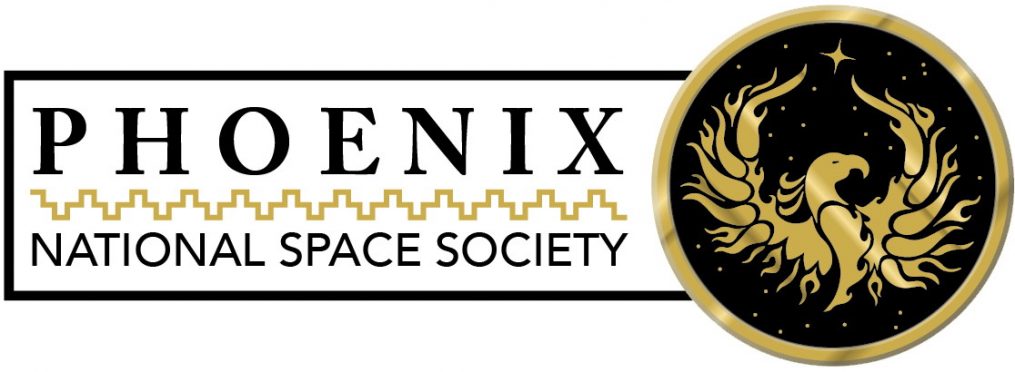
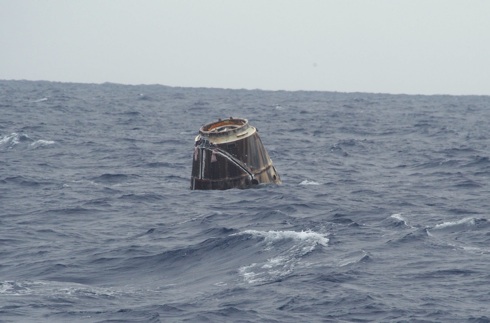
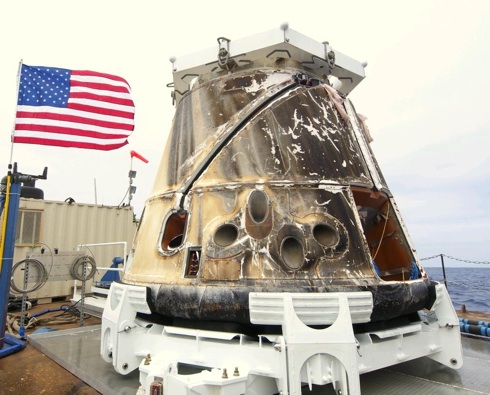
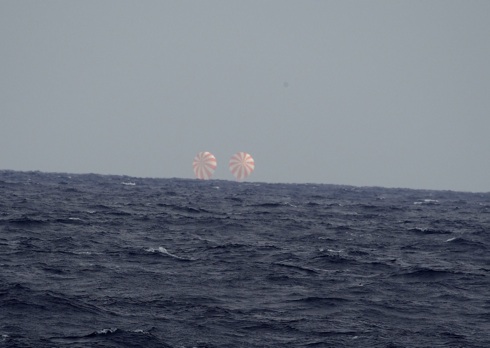
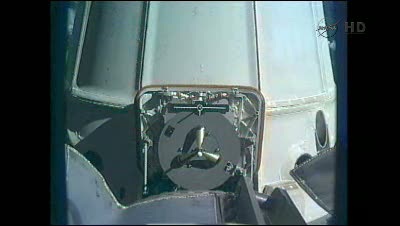
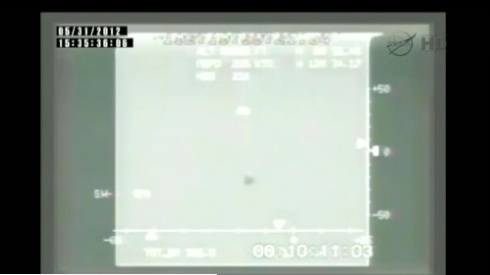
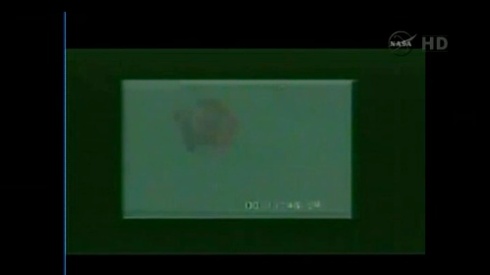
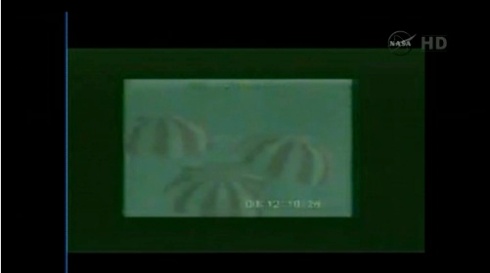
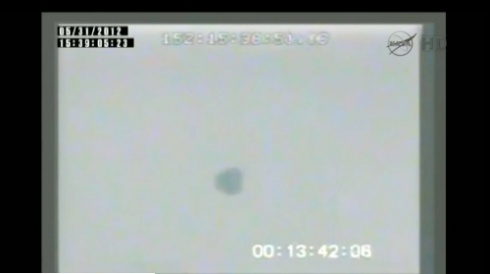

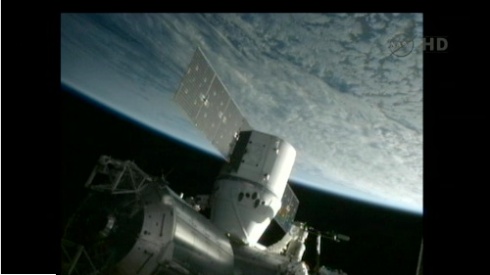
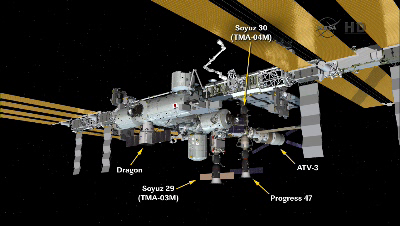
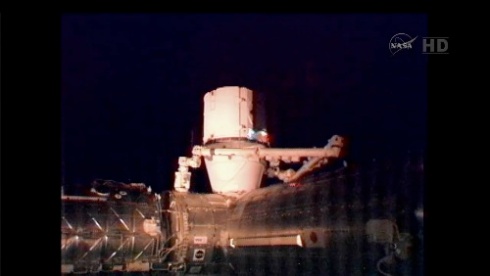
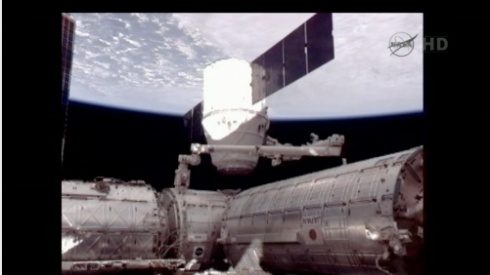
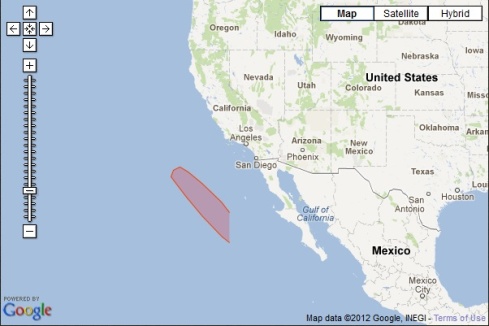
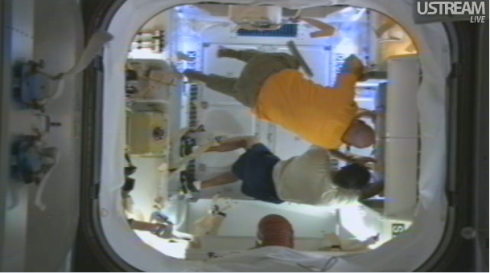
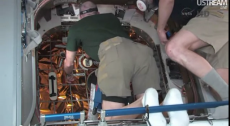
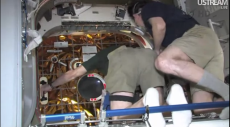
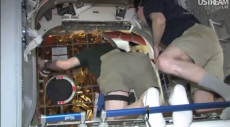
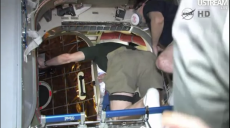
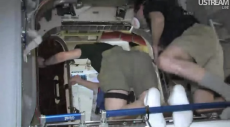
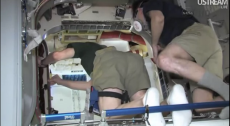
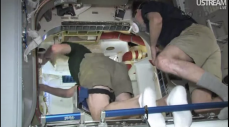
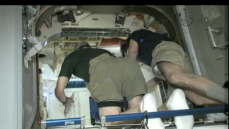
You must be logged in to post a comment.